Millions of asteroids are currently zipping through our solar system. These rocky remnants of the early solar system receive extra attention when their itinerary brings them too close to Earth—which, fortunately, astronomers can…
Astronomers Just Found a Sneaky Asteroid Near the Sun—and It Highlights a Dangerous Blind Spot
